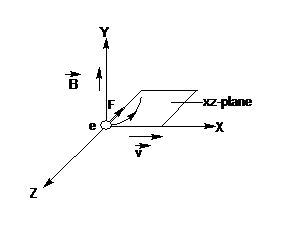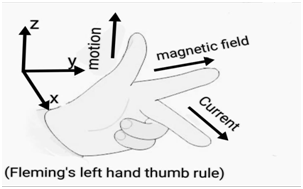
An electron is traveling along the $x-$direction. It encounters a magnetic field in that $y-$direction. Its subsequent motion will be
A. Straight line along the $x-$direction
B. A circle in the $xz-$plane
C. A circle in the $yz-$plane
D. A circle in the $xy-$plane
Answer
218.7k+ views
Hint: When an electron is traveling along the $x-$direction, it encounters a magnetic field in the $y-$direction. If an $x-$axis and $y-$axis are perpendicular to each other, then the direction of the magnetic force acting on the particle is given by Fleming’s left-hand thumb rule. With the help of this rule, we can easily determine the direction of its subsequent motion.
Formula used:
Complete answer:
Consider the unit vectors in $x,y\And z$ the direction be $\hat{i},\hat{j}\And \hat{k}$. Since it is given, the particle moves along the $x-$axis and the magnetic field $\vec{B}$along the $y-$axis.

Let the electron be moving with velocity,$\vec{v}$. So, the force experienced by a charge $q$ in a uniform magnetic field is
$F=q(\vec{v}\times \vec{B})$
$F=q(v\hat{i}\times B\hat{j})$
Or, $F=-e(v\hat{i}\times B\hat{j})$ [Since the charge of an electron is $-e$]
Or,$F=evB(-\hat{k})$
Hence the force acts in a negative $z-$direction. And it will force electrons to move in a circle in the $xz-$plane.
Now, this can be also understood by Fleming’s left-hand thumb rule.

According to this rule, if we stretch our forefinger, middle finger, and thumb in such a way that they are mutually perpendicular to each other. Now the fore finger represents the magnetic field along the $y-$ direction and the middle finger shows the direction of the current along the $x-$direction, then the thumb will show the subsequent direction of motion along the $z-$direction.
Thus, the correct option is (B).
Note:According to the right-hand thumb rule, if we arrange our forefinger, middle finger, and thumb perpendicular to each other then the thumb points towards the direction of motion of the conductor relative to the magnetic field when the middle finger points towards the direction of induced current and forefinger towards the direction of the magnetic field.
Formula used:
Complete answer:
Consider the unit vectors in $x,y\And z$ the direction be $\hat{i},\hat{j}\And \hat{k}$. Since it is given, the particle moves along the $x-$axis and the magnetic field $\vec{B}$along the $y-$axis.

Let the electron be moving with velocity,$\vec{v}$. So, the force experienced by a charge $q$ in a uniform magnetic field is
$F=q(\vec{v}\times \vec{B})$
$F=q(v\hat{i}\times B\hat{j})$
Or, $F=-e(v\hat{i}\times B\hat{j})$ [Since the charge of an electron is $-e$]
Or,$F=evB(-\hat{k})$
Hence the force acts in a negative $z-$direction. And it will force electrons to move in a circle in the $xz-$plane.
Now, this can be also understood by Fleming’s left-hand thumb rule.

According to this rule, if we stretch our forefinger, middle finger, and thumb in such a way that they are mutually perpendicular to each other. Now the fore finger represents the magnetic field along the $y-$ direction and the middle finger shows the direction of the current along the $x-$direction, then the thumb will show the subsequent direction of motion along the $z-$direction.
Thus, the correct option is (B).
Note:According to the right-hand thumb rule, if we arrange our forefinger, middle finger, and thumb perpendicular to each other then the thumb points towards the direction of motion of the conductor relative to the magnetic field when the middle finger points towards the direction of induced current and forefinger towards the direction of the magnetic field.
Recently Updated Pages
A square frame of side 10 cm and a long straight wire class 12 physics JEE_Main

The work done in slowly moving an electron of charge class 12 physics JEE_Main

Two identical charged spheres suspended from a common class 12 physics JEE_Main

According to Bohrs theory the timeaveraged magnetic class 12 physics JEE_Main

ill in the blanks Pure tungsten has A Low resistivity class 12 physics JEE_Main

The value of the resistor RS needed in the DC voltage class 12 physics JEE_Main

Trending doubts
JEE Main 2026: Application Form Open, Exam Dates, Syllabus, Eligibility & Question Papers

Derivation of Equation of Trajectory Explained for Students

Hybridisation in Chemistry – Concept, Types & Applications

Understanding the Angle of Deviation in a Prism

Understanding Collisions: Types and Examples for Students

Understanding Atomic Structure for Beginners

Other Pages
JEE Advanced Marks vs Ranks 2025: Understanding Category-wise Qualifying Marks and Previous Year Cut-offs

How to Convert a Galvanometer into an Ammeter or Voltmeter

Understanding Centrifugal Force in Physics

JEE Main Marking Scheme 2026- Paper-Wise Marks Distribution and Negative Marking Details

Degree of Dissociation: Meaning, Formula, Calculation & Uses

Understanding Electromagnetic Waves and Their Importance




